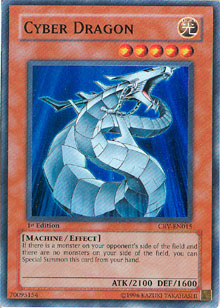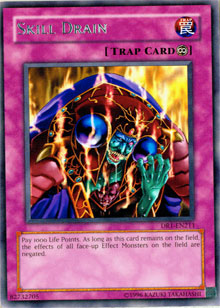Somewhere along the way, players develop knowledge gaps in their understanding of how cards or mechanics work. To be honest, it is a rather arduous task to keep track of card rulings for every card in the Yu-Gi-Oh! TCG, especially when you consider how infrequently many of them are played.
This week we examine issues with summoning Synchro monsters and some common issues surrounding Skill Drain.
Synchro Monsters
The new Synchro summon mechanic should be familiar to most players active in the Yu-Gi-Oh! TCG, but I’ve noticed that certain aspects of the mechanic haven’t quite taken hold. The basic method of Synchro summoning is similar enough to "contact Fusions" that players could quickly grasp the basic idea, but not the details. Players generally understand that they need Tuner monsters and at least one other  monster that they can use as Synchro material. They usually know that they can only Synchro summon a Synchro monster with the same level as the combined total levels of the monsters they sent to the graveyard, but you will encounter players who haven’t quite gotten this yet.
monster that they can use as Synchro material. They usually know that they can only Synchro summon a Synchro monster with the same level as the combined total levels of the monsters they sent to the graveyard, but you will encounter players who haven’t quite gotten this yet.
The problem I have encountered the most is players thinking they can use face-down monsters in their Synchro summon. The rules for Synchro summons state that the Tuner monster and non-Tuner monster(s) must be face up. You cannot use a face-down monster, Tuner or non-Tuner. Every monster you use as a Synchro material monster must be face up. Knowing this, some players will think that they can use Book of Moon when their opponents declare their intention to Synchro summon. Synchro summoning a Synchro monster, like performing a "contact Fusion" or special summoning a monster like Cyber Dragon with an inherent special summon effect, does not start a chain. The opponent cannot respond with Book of Moon until after the Synchro monster is Synchro summoned.
The next Synchro summon knowledge gap involves sending the Synchro material monsters to the graveyard. When players see that the Synchro material monsters are sent to the graveyard, some come to the conclusion that the monsters must be able to reach the graveyard or you cannot perform the Synchro summon. This is not the case.
The Synchro material monsters used for the Synchro summon do not have to reach the graveyard. If another effect, like Macro Cosmos or Dimensional Fissure, removes the Synchro monsters from play instead, the Synchro summon can still be performed. The Synchro material monsters will simply be removed from play instead of being placed into the graveyard. This means that monster tokens can also be used in the Synchro summon, because it doesn’t matter that the monster tokens won’t reach the graveyard.
Skill Drain
Skill Drain is always present in a competitive metagame, even if it isn’t found in any of the top decks at the most recent Shonen Jump Championship. The way Skill Drain works hasn’t changed since its initial release in Dark Crisis, but the knowledge of how it works hasn’t quite taken hold.
Players understand that Skill Drain negates the effects of effect monsters on the field, although some players don’t quite understand what this means. Usually Exiled Force begins this conversation, but lately  Stardust Dragon has been stepping in to take its place. When faced with these cards we see a divergence in the knowledge gap. Some players think that the effects of face-up effect monsters cannot be activated at all. Other players know that the effects of the effect monsters can be activated, but they disagree on the results.
Stardust Dragon has been stepping in to take its place. When faced with these cards we see a divergence in the knowledge gap. Some players think that the effects of face-up effect monsters cannot be activated at all. Other players know that the effects of the effect monsters can be activated, but they disagree on the results.
The players who recognize that Skill Drain doesn’t stop monsters from activating their effects are closer to the truth. To address the problem of Exiled Force and Stardust Dragon, we must remember that Skill Drain cannot negate the effect monster’s effect if the effect monster isn’t face up on the field when its effect resolves. Exiled Force and Stardust Dragon tribute themselves to activate their effects. This is a cost, paid when the effect is activated, not something you do when the effect resolves. Neither monster is on the field when its effect resolves, so Skill Drain doesn’t negate the effect.
How does this affect other monsters? If a Gladiator Beast attacks while Skill Drain is active, it can still activate its effect at the end of the battle phase. When the Gladiator Beast activates its effect, it is returned to its owner’s deck as a cost. It is in its owner’s deck when the effect resolves, and not on the field, so its effect is not negated. The Gladiator Beast it special summons won’t be quite so lucky, because it gets special summoned onto the field, which is Skill Drain’s territory.
Another common Skill Drain avoider is the use of Book of Moon. Since Skill Drain needs the effect monster to be face up on the field when its effect resolves, Book of Moon can interfere by flipping the monster face down before its effect resolves. This works as long as the monster activating the effect doesn’t need to remain face up on the field to properly resolve its effect. (Zombie Master . . . I’m looking at you). This usually isn’t a problem for non-continuous effects.
Suppose your opponent has Skill Drain active and you have Ryko, Lightsworn Hunter set. If you flip summon Ryko, its effect will activate, but Skill Drain will negate the effect when it resolves. However, if you were to chain Book of Moon to Ryko’s effect, it would flip Ryko face down before its effect resolves. This would protect Ryko’s effect from being negated, because Skill Drain won’t negate the effect monster’s effect when the monster is face down. You could use this trick to take out Skill Drain and allow the effects of your other Lightsworn monsters to work properly.
We conclude with Jinzo versus Skill Drain. This question seems to cycle in and out of popularity every year, whenever the two cards find themselves at odds with one another. Each card has an effect that intends to negate the other, and this conflict creates the confusion. The solution depends upon which card is face up on the field first. If Skill Drain is active, when you summon Jinzo or flip him face up, his effect will be negated by Skill Drain, because Skill Drain was already applying its effect when Jinzo was summoned/flipped face up. If Jinzo is face up on the field and Skill Drain is set, Skill Drain cannot be activated because Jinzo’s effect is being applied, preventing trap cards from being activated.
Until next time, send all comments and questions to Curtis@Metagame.com!
—Curtis Schultz